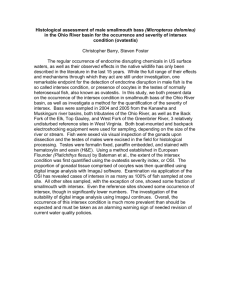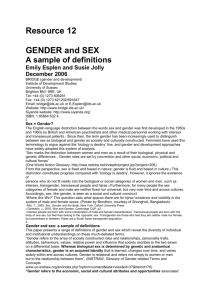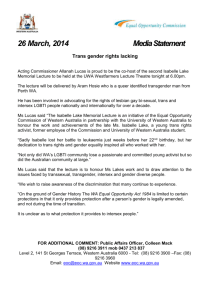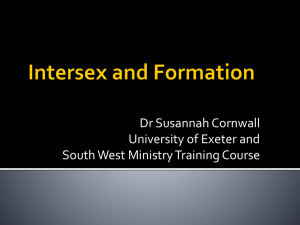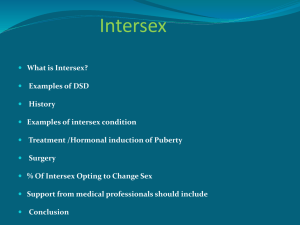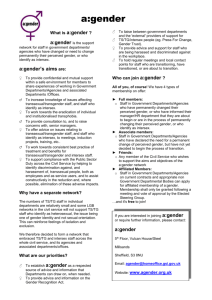submission to the freedom of religion and beliefs paper
advertisement
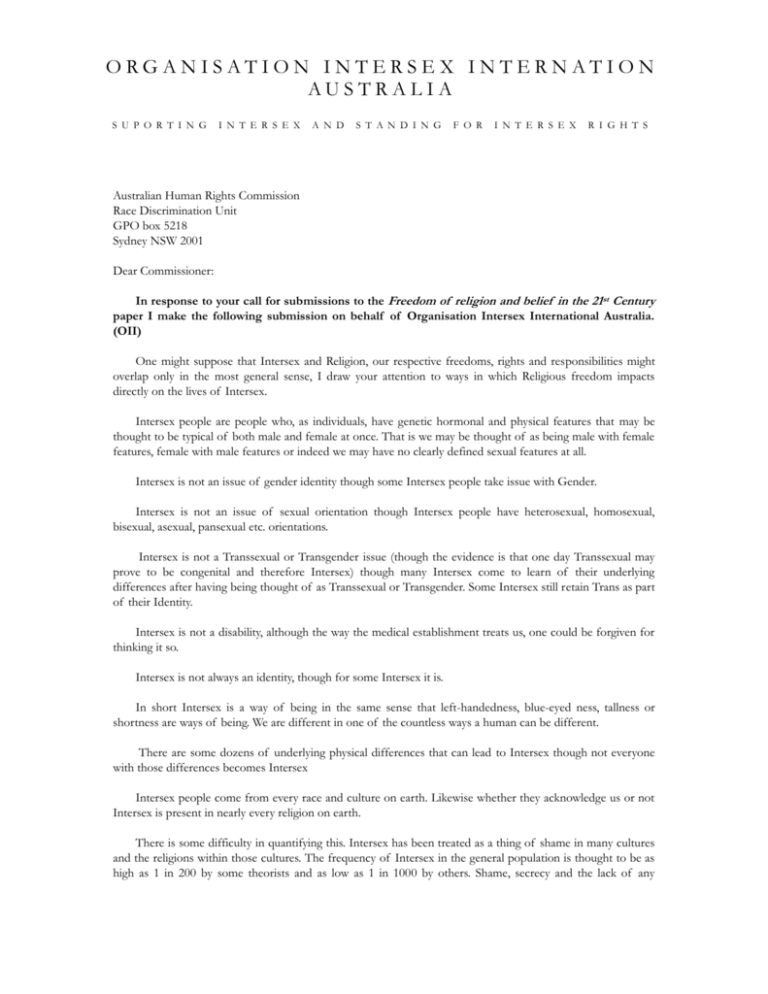
ORGANISATION INTERSEX INTERNATION AUSTRALIA S U P O R T I N G I N T E R S E X A N D S T A N D I N G F O R I N T E R S E X R I G H T S Australian Human Rights Commission Race Discrimination Unit GPO box 5218 Sydney NSW 2001 Dear Commissioner: In response to your call for submissions to the Freedom of religion and belief in the 21st Century paper I make the following submission on behalf of Organisation Intersex International Australia. (OII) One might suppose that Intersex and Religion, our respective freedoms, rights and responsibilities might overlap only in the most general sense, I draw your attention to ways in which Religious freedom impacts directly on the lives of Intersex. Intersex people are people who, as individuals, have genetic hormonal and physical features that may be thought to be typical of both male and female at once. That is we may be thought of as being male with female features, female with male features or indeed we may have no clearly defined sexual features at all. Intersex is not an issue of gender identity though some Intersex people take issue with Gender. Intersex is not an issue of sexual orientation though Intersex people have heterosexual, homosexual, bisexual, asexual, pansexual etc. orientations. Intersex is not a Transsexual or Transgender issue (though the evidence is that one day Transsexual may prove to be congenital and therefore Intersex) though many Intersex come to learn of their underlying differences after having being thought of as Transsexual or Transgender. Some Intersex still retain Trans as part of their Identity. Intersex is not a disability, although the way the medical establishment treats us, one could be forgiven for thinking it so. Intersex is not always an identity, though for some Intersex it is. In short Intersex is a way of being in the same sense that left-handedness, blue-eyed ness, tallness or shortness are ways of being. We are different in one of the countless ways a human can be different. There are some dozens of underlying physical differences that can lead to Intersex though not everyone with those differences becomes Intersex Intersex people come from every race and culture on earth. Likewise whether they acknowledge us or not Intersex is present in nearly every religion on earth. There is some difficulty in quantifying this. Intersex has been treated as a thing of shame in many cultures and the religions within those cultures. The frequency of Intersex in the general population is thought to be as high as 1 in 200 by some theorists and as low as 1 in 1000 by others. Shame, secrecy and the lack of any –2– substantial studies by science and medicine means these things are mostly supposed by even the most renowned experts in the field. http://www.intersexualite.org/VSD.html The problems faced by the intersexed are socio-cultural in nature and not medical. They are a result of the dogmatic fundamentalism inherent in the current binary construct of sex and gender. Some intersexed individuals are subjected to genital mutilation in childhood as a result of this totalitarian view of sex. For this reason, OII denounces all forms of sexism where-ever it may appear in our societies. OII holds that sexism is principally directed against women. However intersexed, and other communities that challenge sex and gender norms are often cruelly treated by that same sexism. Intersex has suffered in many traditional religions. In the Hindu cast system we are called Hijra and occupy the lowest rungs of that social system. Hijra have no access to mainstream society, their human rights are routinely traduced in accordance with the rules of that religion. In Islam, religious doctrine, while acknowledging us, forces femaleness or maleness, without consent irrespective of individual identity. The Islamic position is “It is permissible to perform the operation in order to reveal what was hidden of male or female organs. Indeed, it is obligatory to do so on the grounds that it must be considered a treatment.” In many Muslim societies we are cast out from our families, our communities, and forced into a life of misery. This behaviour is bolstered by Clerics and certain interpretations of religious texts. Christianity treats us no better. In Australia prevailing cultural attitudes about normality are bolstered by religious rationalisations that underlie our moral codes. Intersex bodies seem to defy ideas extant in Christian teachings that God created only men and woman and the primary sexual function of those two ways of being was heterosexual procreation. Australians have a long held antagonistic views of homosexual sex, those views are often rationalised by that tenet of the Christian faith. In this circumstance Intersex bodies cause consternation because same sex intercourse cannot be absolutely ruled out. A person who has genitals that may not be able to engage in penetrative sex, who may not be able to be penetrated, or who may be able to do both, catapults the Christian hetronormative binary into the “briar patch”. The solution to this quandary has been, for as long as it has been possible, sex assignment and surgery to assure that assignment. Many other religions have secret policies, deny that we exist, or re-categorise as Gay or Trans if we prove to be troublesome. In short Intersex does not fare well within the faith community. We are often vilified, demonised or simply eliminated from the possible ways a person of faith can be. We are treated in this way because of our physical differences. Often mainstream morality is informed by religious beginnings and Australia would seem to be that kind of society. The underpinnings of our laws and our moral behaviour to others in the main come from a certain kind of protestant understanding brought along in the first fleet. That understanding included a strongly heterosexual view of Intercourse and a male /female binary for all human beings. Intersex has been forced into that binary. Intersexes like all other citizens are asked to respect the beliefs of others, their political and religious affiliations and the tenets that underlie those. We are asked as civilised humans to consider the contents of Article 18 of the United Nations Charter on Human rights, our laws to a fair extent protect religions from vilification and our constitution protects them from discrimination. This current HRC discussion paper seeks to explore these freedoms and perhaps recommend that they be enshrined in a bill of rights. Religion has, comparatively, enormous freedom to express itself and to practice its doctrines in Australia. These freedoms extend to exempting them from responsibilities such as taxation and council rates. Religion however seems to be unconstrained in their responsibility to respect others who may be different and who do not conform to their view of the world. Intersex is routinely dismissed, sexualised, pathologised, considered mentally disordered, ostracised, reparativised, and demonised by many religious communities. –3– Intersex individuals however do not enjoy the rights of the religious communities that persecute us. We have no specific human rights or legal rights. We have been and continue to be persecuted with impunity by religious organisations. Intersex individuals in every state of Australia are still routinely assigned a sex and endure surgery to confirm that sex, without the individuals consent and without any science to validate the outcomes of this enforced sexing. (See Karkaazis et al 2008) Australian Intersex individuals have had their diagnosis ignored in Catholic hospitals in Western Australia and have been refused treatment for their differences because of underlying religious beliefs in those institutions. (We are prepared to provide in camera evidence of this). OII Australia asks that; if religions and people of faith are allowed to enjoy the freedoms described in article 18 of the UNDHR the Australian constitution and other laws or bills that may emerge from time to time, that that freedom is constrained by equal responsibilities to respect difference. OII Australia considers that all vilification bigotry and prejudice is essentially the same thing and all Australian and Australian organisations, including religious organisations, should be constrained from inciting hatred, vilifying, pathologising, or otherwise abusing others. OII Australia is of the view that Religious organisations have in exercising their freedoms not respected our differences. In response to specific questions put in the discussion paper we make the following observations. the growing interface between science, its actual and potential discoveries and faith traditions, especially in regard to ethical dilemmas . OII Australia takes the view that the medical treatment delivered to Intersex children is based in Religious paradigms that insist on a gender Binary and not on outcomes for children so treated. It is a fact that no long term medical studies have been conducted on Intersex adults that were surgically assigned as infants. . the privatisation of government services and their outsourcing to private bodies including those sponsored by faith communities Intersex Individuals have been refused service, on the basis of Intersex by organisation acting under contract to the government, by religious based organisations. There are specific exemptions in place in NSW for some women’s refuges to refuse entry to people they suppose to be male, irrespective of their identity or presentation. the emergence of issues related to accommodation and dissent in pluralist societies, including internal religious debates, questions around cultural diversity, respect for difference and human rights Intersex experiences prejudice in the provision of faith services by religious organisations because of our differences. We routinely are denied our rights as described under the United Nations charter, by religious organisations, because of our differences. The intersection between freedom of religion and gender equality Whereas, in Australia, most religions enjoy the freedom to practice and believe whatever they like, nearly all absolutely deny sex and gender equality to women and always deny sex equality to intersex people. In the main religious communities ignore our existence, do not offer the support and community they offer to other members of the faith, sometimes vilify us to our fellow believers. –4– What are areas of concern regarding the freedom to practice and express faith and beliefs, within your faith community and other such communities? We are concerned that religions can vilify and discriminate against Intersex with impunity. 1. Is there adequate protection against discrimination based on religion or belief, and protection of ability to discriminate in particular contexts? We are concerned that special protection that allows discrimination in certain circumstances allows religious organisations to marginalise discriminate against and exclude Intersex from faith and faith based services. The Constitution Is this section of the Constitution an adequate protection of freedom of religion and belief? Yes more than adequate. The responsibilities attached to those freedoms need to be included. That is the responsibility not to use a freedom or right to disadvantage or to discriminate against individuals because they are different When considering the separation of religion and state, are there any issues that presently concern you? We are concerned that presently marriage is based in religious dogma and certain people are excluded from marrying because of that dogma. Intersex people are unable to marry as Intersex and if we reject our birth assignment and are perceived as being of the same sex as our partner we are denied the right to marry. Some religious regard the rejection of birth assignments as “Transitioning” from one sex to another. This position is supported by two mistaken ideas. Firstly that despite no knowledge of how a child might eventually perceive themselves and no matter how ambiguous their physical appearance that infant sex assignments are always right and the rejection of that assignment indicates a pathology on the part of the Intersex not a mistake on the part of the attending physician. Secondly that irrespective of physical appearance the individual might be of neither sex or may even have no sex. Given the current definition of marriage being between a man and a woman and the religious insistence on this, Intersex are denied the fundamental human right described in Article 16. We are denied this right even by the United Nations. . Do religious or faith-based groups have undue influence over government and/or does the government have undue influence over religious or faith based groups? We are concerned that religious and faith based groups have undue influence in matters concerning the medical treatment of Intersex, The right to marry as Intersex, The right to an Intersex identity, The right to access faith as Intersex, The right to marriage as Intersex. a) What are the roles, rights and responsibilities of religious, spiritual and civil society (including secular) organisations in implementing the commitment to freedom of religion and belief? b) How should this be managed? –5– OII Australia considers that all rights and freedoms given to religious organisations should be constrained by responsibilities. Intersex are especially concerned that no right should be given that would allow a religious organisation to discriminate against or exclude an Intersex person from any aspect of their faith. Where an Intersex person is denied access to their faith because of their intersex they should have affordable access to legal redress. What are some consequences of the emergence of faith-based services as major government service delivery agencies? Intersex people have in Australia been denied access to services, such as medical services and accommodation, because of their Intersex. Intersex people have been excluded from their faith when they insist on their Intersex as a part of their identity. a) Is there religious radicalism and political extremism in Australia? b) If so, what are the risks to Australia? There has always been religious radicalism in Australia. All religions have at one time or another persecuted minorities and had bigoted and hurtful views of the “Other” in society. Intersex is hardly less vilified or misunderstood than it was 100 years ago in this country. The inclusion of more diverse religions had meant that we are misunderstood and vilified in more ways than ever. The risks to Intersex remain as they always have, exclusion, forced sexing, pathologising, and enforced gender performance. Can you provide any examples of social exclusion in regard to religion? How and why do issues of social exclusion develop? OII Australia can provide concrete examples of Individuals who have been excluded from religion. Because of the shame surrounding Intersex we would need to provide such evidence in Camera. How do you perceive gender in faith communities? OII Australia considers most faith based communities sexist. Women are given subordinate roles and Religion is often used to justify exclusion and inferior treatment on occasion’s physical abuse. Intersex fare less well where our very existence is mostly never acknowledged and the medical abuse we suffer as children justified on the basis of religious perceptions of sex. Do you believe there is equality of gender in faith communities? OII Australia does not believe there is gender equality in most mainstream faith communities. OII Australia is unaware of any faith community that recognises Intersex. How have the new technologies affected the practice and dissemination of religious and faith communities? There is the prospect of greater education of religious individuals on Intersex issues however to date there has also been a flood of bigotry from some faith communities targeting Intersex. The Internet has two sharp edges. Likewise with all other multi media and technological developments. –6– Is there satisfactory freedom of cultural expression and practice within the normative social and legal framework OII Australia considers Intersex individuals are not accorded any legal or human rights protections whatsoever. We consider that we have no enshrined rights anywhere to be who we are. Do service providers in your state or territory support the right to cultural security, safety and competence? No they do not How can the cultural aspirations and human rights of Aboriginal and Torres Strait Islanders be met? What are the issues impacting on Aboriginal and Torres Strait Islander communities at present, and proposed solutions? OII Australia stands in solidarity with the Aboriginal and Torres straight Islander community, supports their right to their Identity and their right to self-determination. How is diverse sexuality perceived within faith communities? For Intersex this is near the heart of our disadvantage. Intersex is perceived very badly in faith communities on the basis that Intersex represents some kind of defiance against the laws of nature, that somehow we are anatomically homosexual. We are vilified, demonised, pathologised, excluded, denied. Of all the communities Intersex come into contact with we receive the worst treatment at the hands of the religious. Often when we are humiliated in public, by a shop assistant or a public servant, that humiliation is underpinned by some religious belief held by our tormentor. the right of parents and guardians to organise family life in accordance with their religion or beliefs This right should never be construed that a parent has a rights over a child rather they have responsibilities to the child. Religious belief should not allow genital mutilation or surgical assignment of non-consenting children. No hormonal or other medical interventions on the basis of religious doctrine should be permitted. Only medicine based in evidential and tested science should be permitted. No child should be subjected to experimental procedures (and all intersex surgery is experimental as no studies of outcomes has ever been conducted). R5.4 The process and remedies available for contravention of the religious vilification provision should be civil remedies similar to those provided for in the racial hatred provisions of the RACIAL DISCRIMINATION ACT 1975 (Cth). And this remedy should be available to Intersex who are vilified by religious organisations To find out more about Intersex please visit our web site http://www.intersexualite.org/Index.html Or read Fixing sex Karkazis 2008 Duke University Press –7– Sincerely, Gina Wilson Organisation Intersex International Australia
